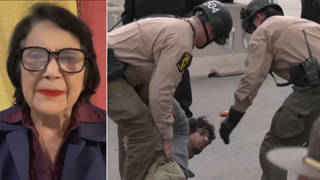
Guests
- Joan Claybrooklongtime consumer advocate, president emeritus of Public Citizen, and the former head of the National Highway Traffic Safety Administration.
- Ken Rimerhis 18-year-old stepdaughter Natasha Weigel died in a car crash in 2005. She was in a Chevrolet Cobalt, a vehicle included in a massive recall last month. He attended the GM hearings this week and was among the victims’ family members who met with GM CEO Mary Barra on Monday.
In 2005, General Motors decided not to change a defective ignition switch redesign because it would have added about a dollar to the cost of each car. At least 13 people have died in accidents as a result, though the number could be much higher. Following two days of contentious congressional testimony by GM CEO Mary Barra, we are joined by two guests: Ken Rimer, whose 18-year-old stepdaughter Natasha Weigel died in a defective Chevy Cobalt in 2005, and consumer advocate Joan Claybrook, former head of the National Highway Traffic Safety Administration.
Transcript
AMY GOODMAN: In 2006, two teenage girls died in a mysterious car crash in rural Wisconsin. [Fifteen]-year-old Amy Lynn Rademaker died within hours after the crash. Eighteen-year-old Natasha Weigel died after 11 days in a coma. The driver of the car survived with brain damage. They were driving in a 2005 Chevrolet Cobalt. For years, the families of the girls attempted to learn what happened. They received some of their answers this week when the CEO of General Motors was called to testify before the Senate over a growing scandal.
In recent months, GM has recalled millions of cars after acknowledging faulty ignition switches shut down engines and disabled air bags. The defects have been linked to at least 13 deaths and possibly hundreds. Internal GM documents show the company decided not to change a defective ignition switch redesign in 2005 because it would have added about a dollar to the cost of each car.
During Wednesday’s Senate hearing, the most hard-hitting questions came from Democratic Senator Claire McCaskill of Missouri, a former prosecutor who chairs the Senate Subcommittee on Consumer Protection. She criticized GM for what she called “a culture of cover-up” and said a GM engineer lied when asked last year about whether the defective part had been changed.
SEN. CLAIRE McCASKILL: A culture of cover-up that allowed an engineer at General Motors to lie under oath—repeatedly lie under oath. It might have been the old GM that started sweeping this defect under the rug 10 years ago, but even under the new GM, the owner of the company waited nine months to take action after being confronted with specific evidence of this egregious violation of public trust. Thousands of my constituents in St. Louis and Kansas City areas go to work for General Motors every day, building some of the finest cars on the road. I am proud of them, and I am proud of their work. This is not their failure. They and the American public were failed by a corporate culture that chose to conceal rather than disclose and by a safety regulator that failed to act.
AMY GOODMAN: To talk more about GM, we’re joined by two guests. Ken Rimer is with us, stepfather of Natasha Weigel, who died in the 2006 accident. Rimer attended the GM hearings this week, was among the victims’ family members who met with company CEO Mary Barra on Monday evening. We’re also joined by Joan Claybrook, former head of the National Highway Traffic Safety Administration and president emeritus of Public Citizen.
I want to go first to Mr. Rimer. Talk about what happened to your stepdaughter, to Natasha.
KEN RIMER: The accident happened—it was on October 24th. She was with two other friends. They took a little bit a side trip from where they lived in Baldwin, or outside of Baldwin, and just headed into a local town to just do a little bit of shopping. On the way back home from there, they—you know, on the side roads, not on the freeway, in the only car on the road at the time, and they—you know, what we had found out through all the accident investigation, you know, the car had shut off, and within five seconds, you know, with the steering wheel locked, the—no power brakes, no power steering, and the air bags dismantled, they went over an adjoining driveway on the road, which caused them to go airborne. They crashed through a—it was a telephone box, and then collided with a group of trees that, you know, caused the extent of all the damage.
AMY GOODMAN: And what did you understand happened at the time?
KEN RIMER: Kind of all we knew at the time was, you know, that—we did know, like I said, the black box did show that the car shut off. But we really didn’t know why. We didn’t have that answer why it shut off. You know, our assumption was, you know, you’ve got three teenage kids riding around in a car; you know, just about anything can happen. And so—and then Megan, the survivor, you know, with the damage, the head injuries that she had and the extensive physical damage, she was a long time recuperating. And, you know, we didn’t get a chance to really talk to her very much after the accident. You know, she was a—she’s got survivor’s guilt, just terrible. I mean, you know, obviously, she survived; her friends didn’t. So, she always looked at it as the accident was her fault. And so, she kind of kept clear—you know, stayed clear from us, and actually, she moved to another state even, just—you know, not necessarily to get away from us, but to just kind of—you know, she was getting a lot of accusations from her friends and that, you know, even just being in the area.
AMY GOODMAN: So, is your daughter, is Natasha, one of the 13 people that GM acknowledges, as well as Amy Lynn Rademaker, the 15-year-old who died—are they two of the 13 people that GM acknowledges died in these crashes with their defective ignition switches?
KEN RIMER: We haven’t seen anything in print that justifies it or that says it exactly. On our first taped episode that we did with the CBS announcer back in February, the producer did call me within a day or so after, you know, when we were putting the segment together, and not sure where he got the information, but he did verify that—this was at the time there was six deaths involved, you know, when we first heard about it back in February. And at that time, he did call me, and he told me that he did verify that Natasha was one of the six, so I would have to assume that Amy then was one of those six originals, as well, then.
AMY GOODMAN: And when did you understand it was the ignition switch?
KEN RIMER: I guess upon the recall. Well, we had seen the—I had seen the bulletin, whatever, the service bulletin from GM. We had copies of that after the accident, you know, when we were trying to piece everything together to find out what happened. And what that service bulletin had said, that with a heavy keychain or a short driver, you know, the ignition could be knocked into the off or the accessory position. So, you know, and the black box said that, too, that the ignition switch did turn off within five seconds prior to the accident happening. So we knew the switch turned off; we just weren’t 100 percent sure whether it was a mechanical or some other thing that could have caused it. But now knowing everything that we do from within the last two months, you know, just everything we’ve read, everything we’ve heard, everything that GM’s putting out, I mean, it’s real obvious that it was the ignition switch, you know, went to the accessory position, shut off the car, basically. And, you know, that’s exactly what caused that accident.
AMY GOODMAN: Did—you met with Mary Barra, the head of GM. What did you say to her?
KEN RIMER: Well, it obviously was just more of a—you know, we tried not to have it as an accusation, you know, pointing fingers. And, you know, obviously, she realizes who we are. The whole idea was to put a face with the people that lost their lives in that accident. You know, it was just a—we were hoping to get a little bit more just personal time, and because, you know, she’s a mother, as well. And it was my wife’s only child, so, I mean, it was just devastating, and it has been devastating to her. And we just wanted to say, “Hey, Mary, you know, just—you know, this is what happened. This is what happened from what GM did or didn’t do.” And, you know, that was kind of the whole idea. You know, she gave a short speech when we first got there, basically to say, you know, she apologized to each one of us specifically. And then, from there, she mentioned, as far as—you know, she can’t change what happened in the past, but she’s putting every effort that she can to change how GM is—you know, handles things in the future. You know, and obviously—
AMY GOODMAN: And have you sued GM?
KEN RIMER: We have filed a lawsuit. I think it was filed about two weeks ago.
AMY GOODMAN: In response to a question from Democratic Senator Richard Blumenthal of Connecticut, GM CEO Mary Barra says she would allow her son to drive a Chevy Cobalt if he only had the ignition key.
MARY BARRA: The testing that has been done has been in—on our proving ground, that has extensive capability where the vehicle would be jarred. And with just the key or the key and the ring, it has—it has performed.
SEN. RICHARD BLUMENTHAL: Is it your testimony here today that those cars are as safe as any other car on the road today?
MARY BARRA: Again, as you look across all the safety technology that is on vehicles from the past to present, there is variation on safety based on the technology that’s on cars today. So there’s variation with—across the whole population.
SEN. RICHARD BLUMENTHAL: Is that Cobalt car, as driven now, safe for your daughters to drive? Would you allow them behind the wheel?
MARY BARRA: I would allow my son and daughter to drive—well, my son, because he’s the only one eligible to drive, if he only had the ignition key.
AMY GOODMAN: That was GM CEO Mary Barra being questioned by Senator Richard Blumenthal of Connecticut. I want to bring in Joan Claybrook to the conversation, former head of the National Highway Traffic Safety Administration. Major questions being raised about why the agencies also did not regulate GM properly. But int he front-page piece in The New York Times today, Rachel Abrams and Danielle Ivory write, “Not only has G.M. twice adjusted the number of deaths it says are linked to an ignition switch defect, but it has also refused to disclose publicly the list of the confirmed victims, now said to be 13.” So, we’re not really clear if Natasha and Amy, the two young women we were just speaking about, 18 and 15 years old, are actually even part of this list of 13, or if 13 is an accurate number. Joan Claybrook?
JOAN CLAYBROOK: Well, without that information, we just don’t know. My belief is that the call centers that General Motors set up about three or four weeks ago, with 50 people answering the phones, have probably resulted in a lot of new information that we don’t yet know about, either. And so, the number could be much, much higher. We had families come to Washington for a press conference to meet the senators and representatives and with Mary Barra and so on. And there were, I would say, almost 13 deaths involved in our—with just our group. And that’s not all the people that have lost loved ones. So, we just don’t know what the numbers are now.
AMY GOODMAN: What about the failure? Go back to the beginning, as you have reconstructed it. You know, you have been head of a major transportation agency, and you, of course, have been a watchdog for so many decades. Talk about what you believe happened with GM.
JOAN CLAYBROOK: Well, in terms of what the National Highway Traffic Safety Administration knew, they, I think, really fell down on the job. First of all, they have some concept that is totally inaccurate, that you have to establish a trend in order to open an investigation of a defect. And that’s just inaccurate. For years, the agency has said, if there is a design defect in a vehicle that can cause failure and it’s a critical safety part that can cause death or injury, that is, per se, a safety defect. And you do not have to have body bags all over the highway in order to say we’ve established a trend.
Now, this was somewhat complicated because they weren’t sure why the air bag was not inflating initially. But as soon as they found out that the ignition switch was turning off, that was a very large hint. And the agency complains that it couldn’t make a finding or even open an investigation until it got more information from General Motors, which was not forthcoming. But I find that to be unacceptable, because the agency has subpoena power. It has investigatory power. It has research and testing power. It has a lot of power. And it really just didn’t apply the capacity that it had.
I would add that they have a very small budget, and so there’s a lot of reluctance at the agency, unfortunately, to open investigations that they don’t see an end to, they don’t see that it’s going to produce the information that they’re going to need. The agency has a $10 million budget for all defects across the entire United States. And that’s less than Mary Barra makes every year. So—and the whole agency only has a budget of $134 million, which is a pittance. So, this agency is really handicapped. And I believe we’re going to need some legislative changes in order to both deter auto companies in the future and also facilitate the agency doing its job.
AMY GOODMAN: Democratic Senator Claire McCaskill of Missouri questioned GM’s Mary Barra Wednesday.
SEN. CLAIRE McCASKILL: Someone at General Motors had switched out the unsafe ignition switches in several car models and covered it up by using the same part number for the same switch—for the new switch. The simple work of the engineer hired by the trial lawyer representing the Meltons had discovered the defective part and its replacement with the same number. And when Mr. Cooper confronted General Motors’ Mr. Ray DiGiorgio, their lead switch engineer, with the evidence of the parts switch, he lied. I guarantee you, if I’m a lawyer and I’m at a deposition where this bombshell has been dropped on my client, that there are two identical—two different parts with the same number, one of which is defective—I guarantee you I don’t go back and tell the folks at the law firm; I’m on my cellphone in the lobby saying to General Motors, “We’ve got a problem.” So, what I want to know is: What investigation began after that deposition?
MARY BARRA: That is part of the investigation that we’re doing.
SEN. CLAIRE McCASKILL: So you don’t know whether or not anything happened after that investigation?
MARY BARRA: I don’t have the complete facts to share with you today.
AMY GOODMAN: Senator McCaskill excoriated GM’s Mary Barra for hiding key documents from family members.
SEN. CLAIRE McCASKILL: A key piece of documentary evidence in a litigation concerning a part that was changed without a part number change, that is spelled out in this document for anyone to read, how does that happen?
MARY BARRA: I cannot—I don’t condone not providing information when requested, you know, in a legal proceeding. And if that was done, we will deal with the individuals accountable for that.
SEN. CLAIRE McCASKILL: Well, I think it’s very important that we find out how many cases this document was provided to counsel in, when it was requested. It’s clearly within the scope. I guarantee you there is not a request for documents being made of GM, around these cases, that the scope of the request did not include this document. And I want to know how many cases they buried this document, because this is what happens in America. Corporations think they can get away with hiding documents from litigants and that there will be no consequences. And I want to make sure there’s consequences for hiding documents, because this is hiding the truth from families that need to know. And it’s outrageous.
AMY GOODMAN: That was Senator McCaskill of Missouri, and she helped The New York Times in identifying one of the 13 victims that they believe are in that 13 list who died as a result of the ignition defect. I wanted to ask you, Joan Claybrook, Michael Moore wrote, “I am opposed to the death penalty, but to every rule there is usually an exception, and in this case I hope the criminals at General Motors will be arrested and made to pay for their pre-meditated decision to take human lives for a lousy ten bucks.” Can you talk about criminal liability here over these years?
JOAN CLAYBROOK: Well, we have been trying since 1966 to get criminal penalties into the Department of Transportation safety statute, and we’ve always failed because the auto companies have opposed it vigorously. But I think that the time has now come to put a requirement that if an auto company knowingly and willfully covers up or refuses to disclose a safety defect or a noncompliance with a safety standard, that they are liable for criminal sanctions. And that would include jail time as well as dollar amounts. So, it’s really past time for that. The Toyota case, where they also did a cover-up with these runaway cars, sudden-acceleration cars, the U.S. attorney, using some power in the Justice Department statute for covering up documents, found a $1.2 billion penalty for Toyota but did not put anybody in jail. It is my belief that until some auto manufacturer employees, whether it’s the top or the middle or whoever did the cover-up, go to jail for allowing a defective system to kill people, that we’re never going to have any understanding within the company of how that culture has to change and safety has to be the number one priority.
There are other things that I think need to be done, as well, which is higher civil penalties. Right now, the maximum is $35 million. I think it ought to be unlimited, with $5,000 per vehicle per violation. And that could add up to billions of dollars. And also, we ought to have less secrecy at the National Highway Traffic Safety Administration. It’s a very secretive agency, does not like being criticized. So it makes it very difficult for the public, for the press, for consumer advocates, to ever get any information out of them and to really exercise any oversight.
So, what we’re talking about here are two major, huge entities that are supposed to be devoted to safety—the Department of Transportation, the auto companies—and both of them have failed to do their job. The NHTSA is not the cop on the beat. It is not determined to find these defects. It has put some false requirement that they have to find a trend in order to make a defect finding. That’s totally inaccurate. That’s never been the case in the agency until recently. And it ought to be abandoned. And they ought to look at what—if there is a design defect in a vehicle, and it can happen, we know it can occur, and it can kill, that’s a, per se, safety defect, and that ought to be totally clarified. And then, also, there ought to be authority for challenges to the failure or refusal of the Department of Transportation to initiate a recall. That authority is not there. So they never feel, inside the agency, that they’re going to be challenged. If the auto companies won’t—
AMY GOODMAN: Joan Claybrook, I just want to point out, General Motors was doing this as it was being bailed out by U.S. taxpayers.
JOAN CLAYBROOK: Correct.
AMY GOODMAN: So it was knowingly killing the very taxpayers who were bailing them out, because they weren’t willing to change a dollar ignition switch.
JOAN CLAYBROOK: That’s correct. And so, that’s another complication here, if you would, for General Motors. But it really is very disturbing for the American public.
AMY GOODMAN: We only have 30 seconds. Ken Rimer, do you believe that GM executives and workers in the company should be held criminally liable for the death of your daughter?
KEN RIMER: They knew what was going on. They were aware that the switch was not correct. I mean, there—and, you know, all through the organization—I can’t just put the blame on one person, but there’s many there that made that decision. And then there’s also many more that made the decision to hide that. So, yes, I mean, they need to be held accountable for those decisions that they made, and throughout process, not just the guy that signed off the original paper, but, you know, his supervisor and all the way up the chain of command.
AMY GOODMAN: Ken Rimer, I want to thank you for being with us, and our condolences on the death of your 18-year-old stepdaughter Natasha Weigel. She died in the car crash in 2006, along with her friend. I also want to thank Joan Claybrook for joining us.












Media Options